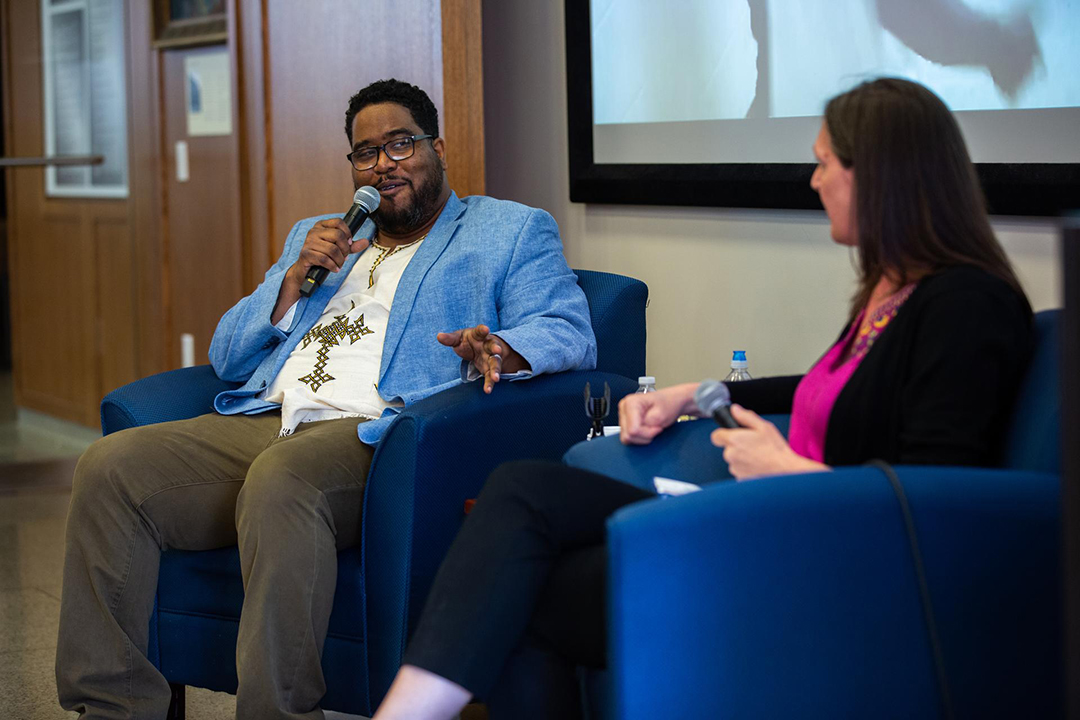By Tatyana Hopkins
Mary Ann Stinson and Michael Redmond II, two doctoral students who met in their classes in the George Washington University Graduate School of Education and Human Development, share an unwavering commitment to closing the vast achievement gap between white students and students of color in the public schools of Washington, D.C.
And they are using creative, data-driven strategies to do it.
As administrators, the pair transformed the Truesdell Education Campus in the Petworth neighborhood of Northwest D.C. into one of the most innovative schools in the city, producing dramatic increases in student academic gains and outcomes.
When Ms. Stinson, who was previously an educator in Richmond, Va., joined the D.C. school as principal in 2010, only 20 percent of its students read at or above grade level. Now nearly 90 percent of its students read proficiently or at higher levels.
“Passion and purpose came together and had some wonderful results,” Ms. Stinson said.
Truesdell, which serves students in grades pre-K through eighth, had experienced substantial increases in the number of English language learners and children from low-income households and minority backgrounds. These populations often face disparities in academic results and progress.
“It’s not the kids, and it’s not an achievement gap,” Ms. Stinson said. “It’s an opportunity gap.”
Having implemented high-level and heavily personalized reading instruction when she began her role as principal, Ms. Stinson saw gains in reading proficiency within her first few years at the school.
However, despite the increased proficiency by the time Mr. Redmond joined Truesdell as the assistant principal in 2015, the two noticed there was still not a “culture of reading” at the school. In fact, fifth-grade boys’ performance was beginning to decline.
“We did not see that real love of reading and having kids reading as a scholar would read, and we wanted to make sure we were exposing students to texts they would really enjoy,” Ms. Stinson said.
So, one day she handed a fifth-grade student a copy of “Bad Boy: A Memoir,” a book by African American author Walter Dean Myers, and told him to start reading.
Mr. Redmond overheard the exchange and invited two more students to read the book. By the end of the day, fifth-grade boys flocked to their offices asking for a copy, leading to the formation of a book club for the boys in that grade.
Mr. Redmond, who studies how students form a scholar identity and barriers that young black students face in educational achievement, hoped to use the book club to shatter a narrative that boys of color are incapable of reading. They later established a companion group for the girls.
Within two months, the school’s library could not keep up with the demands for the club’s featured books, which often highlighted the experiences of black and Hispanic characters.
“We wanted to expose our kids to a set of texts that looked like them, sounded like them and that they would be able to get into,” Mr. Redmond said. “They ended up reading more than I could have ever imagined and at levels way beyond what fifth graders traditionally read.”
Through implementation of research on adverse childhood experiences, linguistically and culturally diverse student populations and school disciplinary policies acquired in their GW classes and educational policy institutes, Ms. Stinson and Mr. Redmond were able to increase student learning and attendance as well decrease disciplinary issues.
“Mr. Redmond shared some research about disciplinary exclusion practices and suspension and how one suspension could lead to a student dropping out of high school,” Ms. Stinson said “I didn’t want to be a part of that, so I stopped suspensions.”
She said Mr. Redmond’s presence as an African American male also had a huge impact on how they shaped the student experience at Truesdell.
“Being an older white woman, I felt like I had a lot of affirmations for kids, and I didn’t really consider gender or race coming in to play with that,” she said. “But watching Mr. Redmond in action I realized representation matters.”
Together, they shaped Truesdell’s mission to become a “model school community that transforms children with love into premier scholars, citizens and leaders of tomorrow, capable of fundamentally disrupting systemic racism in order to achieve their full potential and thereby removing the barriers for other to fulfill their wildest dreams.”
Currently, Ms. Stinson is an instructional superintendent for a cluster of D.C. public schools in Wards 7 and 8—areas with the city’s highest concentration of poverty. Mr. Redmond is also now the assistant principal of Ward 8’s Kramer Middle School, which serves a nearly all black population in the economically disadvantaged ward.
Although they no longer work together on a daily basis, they said they continue to share ideas and use data-driven teaching techniques to disrupt the status quo of the traditional teaching establishment, transform the roles of teachers and drive widespread improvement.
“All kids have the ability to be successful, and they may not be into traditional classic novels,” Mr. Redmond said. “It is up to us as school leaders to create spaces that work for kids and not make kids work for spaces.”




